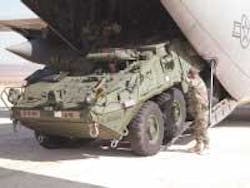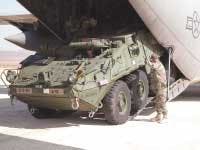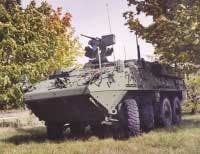Robotics are key to future of vertronics
By John McHale
Army experts are turning toward robotics in vehicular electronics to help control unmanned ground vehicles for use on future battlefields. Meanwhile military electronics designers are turning toward commercially and custom-developed electronics to run the lightweight generation of armored combat vehicles just starting to be fielded.
Much like their colleagues in the U.S. Air Force and Navy have done with aircraft, U.S. Army officials are looking to implement unmanned capability in their ground vehicles. The latest thinking has it that the Army's Future Combat System (FCS) will need complementary vehicles to move quickly in heavy fighting. Experts see unmanned capability as the way to do reconnaissance and related battlefield tasks while keeping human casualties to a minimum.
The FCS is the backbone of the Army's long-term transition plan to reach what it calls the objective force, say officials at Boeing in Seattle, the FCS prime contractor. The FCS, a networked system of advanced communications and light, mobile armored vehicles, is the core building block to develop what Army leaders call overmatching combat power, sustainability, agility, and versatility necessary for a wide variety of military operations.
This next-generation objective force will be lighter and more mobile than forces are today; the Army transformation requirements include the ability to put a combat-capable brigade anywhere in the world within 96 hours, a division in 120 hours, and five divisions on the ground within 30 days, Boeing officials say. A brigade has 3,000 to 5,000 soldiers, while a division has 9,000 to 15,000 soldiers.
Robots at TACOM
Experts at the Army's Tank-automotive and Armaments Command (TACOM) in Warren, Mich., are working with robotics to make FCS unmanned vehicles a reality. TACOM's Robotic Follower advanced technology demonstration represents the organization's focus on providing a mature unmanned capability to the Future Combat System (FCS) program.
The Robotic Follower seeks to develop, integrate, and demonstrate candidate unmanned "follower" robots for early use in the FCS program, as well as to achieve unmanned capabilities for future land combat vehicles, TACOM officials say.
The Robotic Follower will trail behind manned vehicles as they move into battle. The follower vehicles are to handle tasks such as the re-supply of platoons, fire, rear security, and support of manned combat, tactical, and support vehicles, says Curt Adams, assistant director for vetronics technology at the Vetronics Lab at TACOM. Vetronics is short for vehicular electronics.
The Robotic Follower will be semi-autonomous; it will be given a destination and route to follow, and will be able to sense bumps in the path or obstacles and maneuver around, Adams explains. It senses the terrain via a laser radar (ladar) system and uses the Global Positioning System to determine its position, Adams adds.
"The Robotic Follower Advanced Technology Demonstration (ATD) speeds the integration of robotics into the next generation of land systems with an emphasis on the technical approach to achieve the coupling of advanced perception technology with human sensing and reasoning," Adams says.
"Applications for this operational mode are logistics vehicles and non-line-of-sight weapon platforms," he continues. "In each instance the soldier operating the lead vehicle chooses paths that avoid serious obstacles to forward mobility, uses terrain to provide cover and concealment, and avoids paths that would compromise RF communications capabilities, providing much of the intelligence required for subsequent autonomous unmanned follower vehicle mobility. The lead vehicle automatically transmits its path to the unmanned follower vehicles, as a series of waypoints or closely spaced grid coordinates, over tactical command and control data networks.
"The followers, incorporating limited perceptual capabilities to detect any new obstacles that have appeared since the passage of the leader, follow the path defined by these 'breadcrumbs,' potentially with significant physical or temporal separation," Adams explains. "The key technical achievement of this program is the ability for unmanned vehicles to autonomously maneuver over terrain, without the necessity of a soldier 'driving' the vehicle or requiring extensive mission preplanning.
"The Robotic Follower ATD has been structured to develop, integrate, and demonstrate the technology required to rapidly incorporate this technology into future military systems for both mounted and dismounted warfare," Adams says. "It will conduct applied research and field experimentation to successively demonstrate a maturing autonomous mobility capability, placing primary emphasis upon the development and implementation of advanced perception algorithms required to rapidly detect and classify mobility obstacles. It will focus upon fusing information from multiple sensors to provide capabilities for operation during day, night, and limited visibility."
The vehicle can also be controlled remotely if necessary, Adams says.
Last year TACOM experts demonstrated an experimental unmanned vehicle with the capability to maneuver on primary roads at speeds of nearly 20 miles per hour and off-road at speeds of almost 10 miles per hour. The follower vehicle was able to detect obstacles above the ground plane that are half a meter high or obstacles below the ground plane, such as ditches or gullies, that are one meter wide, while following a lead vehicle at a distance ranging from 50 meters to 500 meters, Adams says.
Early next year TACOM officials plan to improve the vehicle's speed to 30 miles per hour, with an off-road speed of almost 20 miles per hour and a range of 100 miles, Adams says. The vehicles will be able to detect above-ground plane obstacles as small as one foot high and below -ground plane obstacles as narrow as half a meter wide. The range of potential vehicle separation will be increased to between 20 meters and 1 kilometer, while the permissible time delay between passage of the manned leader and unmanned follower vehicle will be demonstrated as long as 1 hour. At the same time, anticipated requirements for operator intervention will be reduced to 75 percent of the 2001 level.
By 2006, when the robotic follower is demonstrated as part of the Future Combat System, TACOM officials say they expect the vehicle will be capable of maneuvering on primary roads with a top speed of between 50 and 60 miles per hour and off-road at speeds as fast as 40 miles per hour with a vehicle range of between 180 and 450 miles. The range of potential vehicle separation will increase to between nine feet and six miles, with potential for further increase. Improvements in vehicle intelligence and software reliability combined with the inherent mobility of the FCS chassis should reduce the requirement for operator intervention to once every 30 minutes, if not lower, Adams says.
The main processor used on the robotic follower robotics system is a Power PC Generation 4 on a VME form factor, Adams says. Many of the components used are commercial-off-the-shelf (COTS), but the systems and sensors are mostly custom designs, he adds.
Command and control
The relatively light vehicles of the Future Combat System will also be part of a digital battlefield and will need much more sophisticated and integrated electronics for command, control, communications, computers, and intelligence (C4I) systems than do today's combat systems, experts say. This will require the use of COTS technology in a small embedded format.
TACOM officials are also using commercial technology to improve simulation training among vehicle operators. TACOM's Crew integration and Automation Test bed (CAT) ATD is demonstrating a multi-mission-capable two-man crew station platform concept, which will be integrated into a C-130 transportable chassis supporting the Army's objective force, TACOM officials say. This program focuses on an improved soldier machine interface (SMI) design using indirect vision driving and automated decision aids, an advanced electronic architecture design/network topology, and embedded simulation.
"Now, instead of having the crew train on a simulation outside the vehicle they can do it while they're sitting in it," Adams says.
The SMI technology includes indirect vision, speech recognition, 3D Audio, crewman's associate interface, and a helmet-mounted display with panoramic displays. Robotics will be used on this application in the form of a semi-autonomous sensor suite, Adams says.
The technology has started out being mostly custom, but has an ever-increasing COTS baseline, Adams says.
One example of COTS on the crew trainer is the embedded processor, a GeoForce 4 from nVidia, which makes processors for the computer gaming industry. The gaming industry leads the way in 3D technology, with new devices every six months, he adds.
The vehicle currently being used for demonstration is the Army Stryker vehicle, designed by engineers at General Dynamics Land Systems in Muskegon, Mich. Stryker is a family of eight-wheel drive combat vehicles easily transportable in C-130 cargo aircraft.
Traveling at speeds of 62 miles per hour on highways, Stryker has a range of 312 miles. In the Mobile Gun System configuration, it carries a General Dynamics 105 mm tank cannon in a low profile, fully stabilized, "shoot on the move" turret, General Dynamics officials say. Its armor protects the three-soldier crew from machine gun bullets, as well as from mortar and artillery fragments. The Stryker Mobile Gun System can fire 18 rounds of 105 mm main gun ammunition, 400 .50 caliber bullets, and 3,400 7.62 mm bullets.
General Dynamics C4I systems experts in Taunton, Mass., designed an Embedded Training Module, for the Stryker vehicle. The unit performs double duty as a graphics processor for gunnery training and server storage for interactive electronic tech manuals. It is conduction-cooled in a sealed box with MIL-STD-1275 DC input power. The unit has CompactPCI single-board computer with dual mobile Pentium III processors and twin nVidia graphics engines.
"It is ostensibly a militarized Xbox, supporting the Army's objective to train how they fight," says Chris Marzilli vice president of marketing at General Dynamics C4I Systems. The Stryker is part of the Integrated Fighting Force Combat Brigade Team, which is the interim force between the Army of the nineties and the objective force.
The new vehicles have low weight as a major requirement, therefore the electronics must be packaged in small embedded form factors, he explains. Each mission will also have different parameters, which will require custom-designed electronics subsystems built with many COTS components, Marzilli adds.
Experts at General Dynamics C4I Systems use devices such as a custom-designed multi-processor unit (MPU) that is suited for airborne, shipboard, and ground-based tactical operations centers. The configurable MPU consolidates as many as six single-board computers onto one chassis.
One use for the MPU is Maneuver Commander's Environment Constituents. These units consist of a rugged Cisco 3640 router with 4-slice MPU pair that has eight logically independent CompactPCI single-board computers for mixed Unix, Windows, and Linux software applications, Marzilli says.
"The MPU is effectively a full-features Tactical Operations Center in a box deployable across the battle spectrum on land, sea, or air," Marzilli says.
General Dynamics C4I engineers used an MPU that had a CompactPCI mid-plane design, with five Sun SPARC boards and one Intel Pentium-based board for the Army's Black Hawk Helicopter, Marzilli says. However the MPU can use any combination of Sun SPARC- and Intel Pentium-based single-board computers, depending on the user requirements, he adds.
Each module operates as a logically independent stand-alone workstation, with its own keyboard, mouse, and monitor connections; and native motherboard I/O that extends to external chassis interface connectors, company officials say. An internal 10/100 BaseT Ethernet switch in the MPU connects all the modules together on an internal local-area network, while a second Ethernet port remains available on each module to connect to an external local-area network.
The systems will be independent of the platform for smoother upgradeability, Marzilli adds.
The company also has a lightweight computer unit "that will be installed this fall in the Bradley tracked and Hummer wheeled vehicle variants for close combat fire support missions," Marzilli says.
The computer will have a 1 GHz Pentium III microprocessor with 2 gigabytes of RAM and a 12-inch liquid crystal display. The unit will also be conduction-cooled in a sealed box with AC-DC power input with battery-backed uninterruptible power supply.
For small embedded applications General Dynamics C4I Systems engineers offer 1U and 2U Sun Ultra SPARC and Intel Xeon servers. The Sun device is a "space efficient, stackable, scaleable, server for 64-bit SPARC/Solaris processing," Marzilli says.
Light and lethal
The Future Combat System of the Army, which will be small, light, and digitally enhanced, will be even more lethal, survivable, and mobile than today's combat vehicles. The reduction in weight will also require a reduction in the amount of armor on the lighter vehicles. The new platforms will not be totally bare but will have a sophisticated electronic protection system integrated into the vehicle with the armor.
Engineers at TACOM's Survivability group are working on an active electronic protection system that will be able to defeat threats such as incoming missiles from handheld launchers, says Steve Scheher, associate director of the Survivability Group at TACOM. The system will use passive sensors that offer no active emissions for the enemy to detect, Scheher says.
The sensors provide data to the commander's control unit in the vehicle, which determines the actual threat and appropriate countermeasures. These sensors help the commander decide between soft countermeasure such as electronic warfare jamming or hard countermeasures such as launching a weapon, Scheher says.
Prior to the active protection system, armor, smoke grenade launchers, and missile countermeasures protected vehicles, Scheher says. Much of the technology used for the active protection system comes from aircraft survivability work and is modified for use in ground vehicle applications, he says.
Experts from United Defense LP in York, Pa., also used a version of this technology earlier this year when they successfully demonstrated the first simultaneous defeat of two live threats by the Integrated Army Active Protection System integrated on a U.S. combat vehicle, under a TACOM Integration Program contract.
"The successful intercept of two incoming, simultaneous threats has never been achieved previously on a U.S. ground combat vehicle," says Val Horvatich, general manager of United Defense's Advanced Development Center. "The ability to actively protect ground combat systems from hostile threats using systems other than armor is key enabling technology for the Army's Future Combat Systems."
The Integrated Army Active Protection System (IAAPS) is integrated on a ground combat vehicle and is undergoing testing. The suite includes two types of passive sensors — infrared and visible-light — as well as electronic warfare soft kill countermeasures, and an active protection hard kill system composed of launcher, radar, and a deployed countermeasure.
The IAAPS program, which is an Army Science and Technology Objective, has successfully demonstrated an integrated survivability system on a ground combat vehicle, which is designed to increase vehicle survivability while allowing for a decrease in armor and vehicle weight, United Defense officials say.
United Defense experts have demonstrated the integrated suite several times on tasks such as detection, classification, and selection of the appropriate countermeasure; tracking and computation of the fire control solution; and defeat by electronic-warfare soft kill or active-protection hard kill. The suite has defeated two live threats fired at one vehicle at the same time without the use of armor as the primary means of defeat, United Defense officials say. The next phase in demonstrating IAAPS capabilities involves defeating incoming threats while on the move.
United Defense to provide for Bradley Advanced Training SystemsOfficials at the U.S. Army's Tank-automotive and Armaments Command (TACOM) in Warren, Mich., recently selected United Defense in York, Pa., to modify 11 Bradley Advanced Training Systems (BATS) and spares. The contract includes an option for two image generators, plus extra spares.
The contract, managed by the Simulation, Training & Instrumentation Command (STRICOM) in Orlando, Fla., calls for five gunnery training systems to be delivered to Fort Knox, Ky., in May 2003 and six to be delivered to Fort Benning, Ga., in July 2003. Work on the contract will be at United Defense's Orlando facility, company officials say.
"This is one of the U.S. Army's most sophisticated training systems," says Mark Russell, United Defense's Simulation and Training Systems group manager. "The feedback we've re-ceived from the users of the first 13 BATS units has been very positive. The training systems allow soldiers to hone their combat skills and be ready for their missions."
BATS units enable soldiers to train on the Bradley A3 system using software that integrates computer graphics featuring a virtual battlefield display, United Defense officials say. The virtual training replicates climate, topography, and threats that a Bradley crew could face on a battlefield.
For more information on United Defense contact the company on the World Wide Web at http://www.uniteddefense.com.
Vista Controls VMEbus technology chosen for Korean tracking systemEngineers at Raytheon Co. in Lexington, Mass., recently chose designers at Vista Controls Corp., a Curtiss-Wright company, in Santa Clarita, Calif., to provide the control electronics unit in the Korean Electro-Optical Tracking System (KEOTS) for the Republic of Korea army's Flying Tiger vehicle. Raytheon engineers are providing the integrated KEOTS subsystem.
The VMEbus-based System Controller Unit (SCU) for KEOTS comprises an air transport rack with nine rugged commercial-off-the-shelf VMEbus cards, two of which are customer-furnished equipment.
Since work on the unit began, Vista Controls engineers have developed and updated the processor and I/O modules through technology insertion in line with their TMI (Technology Migration and Insertion) program to mitigate the effects of component obsolescence and diminishing manufacturing sources, Vista officials say. Vista Controls also developed some of the stabilization and control law libraries as part of the actual application software, company officials say.
KEOTS is an advanced ground-to-air, passive fire-control system that consists of a second-generation FLIR (forward-looking infrared radar) sensor with a charged-coupled-device visible-light sensor, both of which are bore sighted to a long-range, high-repetition-rate laser range finder, Vista officials say.
Designed to protect forces from low-flying aircraft, KEOTS provides the Flying Tiger — a self-propelled anti-aircraft gun system — with a passive capability to acquire, track, and engage aerial targets.
First prototype deliveries to Raytheon of Vista Controls' KEOTS SCU are expected in the spring, with full production following in May, Vista officials say.
For more information on Vista Controls contact the company on the World Wide Web at http://www.vistacontols.com.


